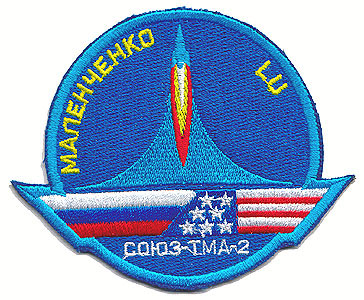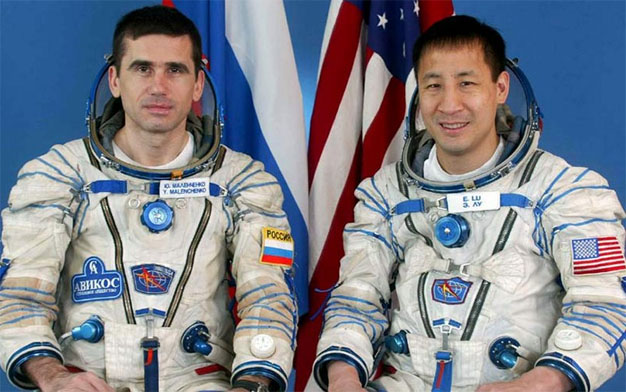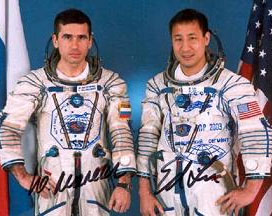
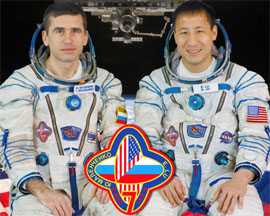
The Soyuz TMA-2 spacecraft with a "tail" number 212 became the 6th Soyuz to fly to the ISS. The original crew of the Soyuz TMA-2 was typical for a "taxi" mission: a Russian commander, a European researcher and, possibly, a paying passenger.
In the spring of 2001, European Space Agency, ESA, and Russian Aviation and Space Agency, Rosaviacosmos, signed a "frame" agreement on several commercial flights of European astronauts with the taxi crews to the ISS. Under this agreement, ESA astronauts, representing different European countries, would accompany Russian crewmembers during a week-long taxi missions to the ISS.
By the end of 2002, Russian space officials named cosmonaut Gennady Padalka and ESA astronaut Pedro Duque, representing Spain, as the commander and flight engineer, respectively, for the 5th taxi mission to the ISS. The third seat onboard the Soyuz TMA-2 remained available for a highly anticipated "tourist" candidate.
Upon completion of medical tests, Chilean pilot Klaus von Storch was to join a Russian commander and a European flight engineer, training for a week-long mission onboard the Soyuz TMA-2 spacecraft, scheduled for launch to the ISS in April 2003.
However, due to lack of funds, Chilean space dreams had never materialized, and neither had the ambitions of a Russian tycoon, who, reportedly promised to pay for his seat onboard the Soyuz TMA-2.
As a result, Russian officials considered including a trained Russian cosmonaut into the Soyuz TMA-2 crew or even flying a cargo container onboard the spacecraft. All these plans came to an abrupt end on a fateful morning of February 1, 2003.
The tragic loss of the Shuttle Columbia during her voyage home at the end of the STS-107 mission, essentially grounded the US manned space program for the indefinite period of time.Although the exact impact of the Columbia tragedy on the ISS program was not immediately known; every possible scenario would require Russia to play an active role in the project in the foreseeable future.
On April 1, 2003, or exactly two months after the loss of Columbia, NASA officially confirmed that had been known for weeks -- a veteran Russian cosmonaut Yuri Malenchenko (Col., Russian Air Force) and veteran NASA astronaut Ed Lu have been named as the primary crew for the planned April 26, 2003, launch of the Russian Soyuz TMA-2 spacecraft to the International Space Station.
At the time of the Shuttle accident, Malenchenko and Lu, along with the Russian cosmonaut Alexander Kaleri had been in training as the 7th long-duration crew of the ISS. The trio was scheduled to blast off toward the ISS onboard the Space Shuttle Atlantis on March 1, 2003. In the wake of the Columbia tragedy, Kaleri was bumped from the ISS-7 crew to save resources onboard the station. Instead, Kaleri and his NASA colleague, astronaut Michael Foale, were named the backup crewmembers to the primary ISS-7 crew.
The successful launch of the Soyuz TMA-2 (No. 212) spacecraft took place at 7:53:52 Moscow Time on April 26, 2003. After a two-day autonomous flight, the Soyuz TMA-2 successfully docked to the nadir (Earth-facing) docking port of the station's Zarya FGB module at 09:56:20 Moscow Time on April 28. One hour and twenty minutes later transfer hatches separating the station and the Soyuz spacecraft had been opened and two crews reunited onboard the ISS.
After arrival of the eight expedition to the station in October 2003 and a week of handover operations, the seventh crew of the ISS and the European visiting researcher, boarded the Soyuz TMA-2 spacecraft and undocked from the station's Zarya module at 02:17 Moscow Time on October 28, 2003.
According to Russian officials, shortly before undocking, an erroneous command onboard the Soyuz TMA-2 apparently activated its thrusters, which disrupted the attitude control of the ISS and required unplanned maneuvers to counteract the change in the orientation of the outpost, which reached as much as 25 degrees.
At 04:47 Moscow Time on October 28, the Soyuz TMA-2 initiated a braking maneuver, which lasted four minutes and 17 seconds. The separation of the habitation and service modules from the reentry capsule took place around 05:14 Moscow Time, RKK Energia said. According to NASA, a braking parachute was released around 9:25 p.m. EST (Oct. 27). Russian search and rescue personnel reached the reentry capsule safely on the ground shortly before 10 p.m. EST on October 27, 2003. (It was October 28, 2003 Moscow and Kazakhstan time.)
According to RKK Energia, the touchdown took place at 05:40 Moscow Time 38 kilometers from the town of Arkalyk in Kazakhstan (49.55 degrees N and 66.57 degrees E). The Soyuz TMA-2 and its crew logged 185 days in space.
(Thanks to russianspaceweb.com for this information)
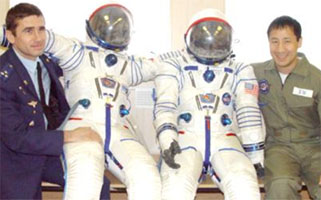
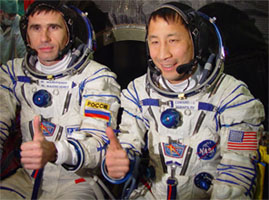
Left: The Soyuz TMA-2 crew with their flight suits. Right: Final training in the Soyuz spacecraft with training Sokol suits.
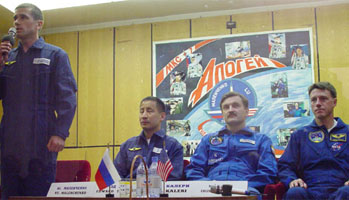
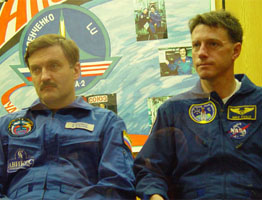
Final Press conference before launch, the prime and back-up Soyuz TMA-2 crews, Behind them you can see the TMA-2 artwork.
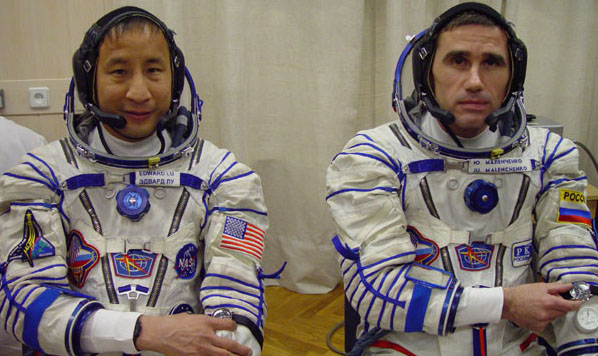
The Soyuz TMA-2 crew set their watches a few hours before lift-off.
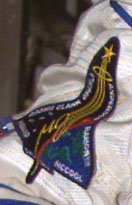
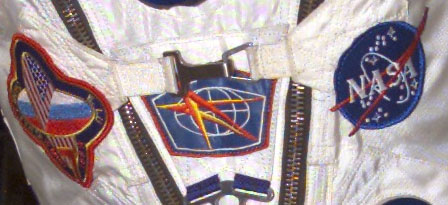
Close up of Ed Lu's Sokol suit, He was wearing the STS-107 patch on his arm, The EXP-7 patch, Zvezda patch amd NASA patch on his chest.

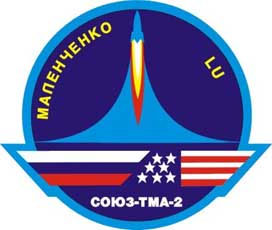
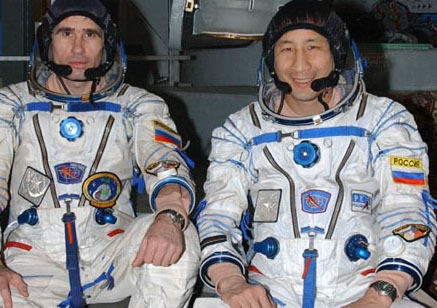
The Soyuz TMA-2 crew with a lot of Alex Pancehnko patches on their training Sokol Suits.
